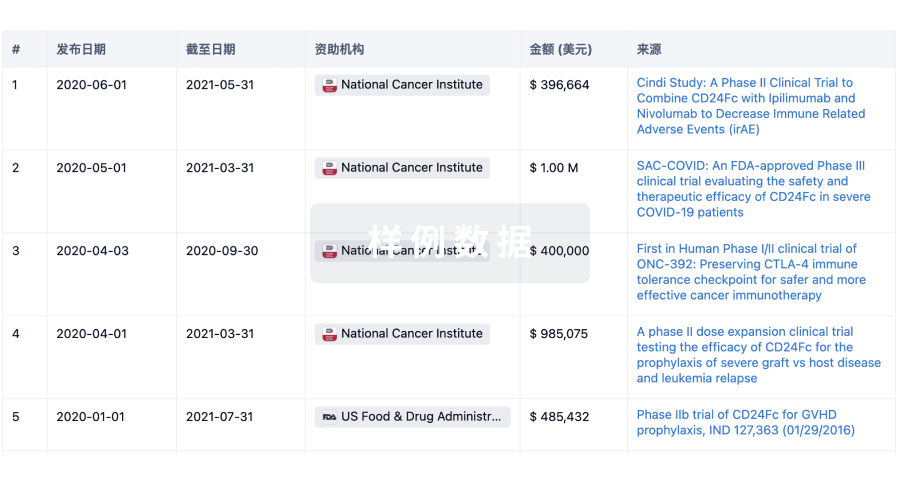预约演示
更新于:2025-05-07

Neogene Therapeutics, Inc.
更新于:2025-05-07
概览
标签
肿瘤
消化系统疾病
内分泌与代谢疾病
TCR-T细胞疗法
基因疗法
疾病领域得分
一眼洞穿机构专注的疾病领域
暂无数据
技术平台
公司药物应用最多的技术
暂无数据
靶点
公司最常开发的靶点
暂无数据
| 排名前五的药物类型 | 数量 |
|---|---|
| TCR-T细胞疗法 | 3 |
| 基因疗法 | 1 |
| 排名前五的靶点 | 数量 |
|---|---|
| KRAS G12D(KRAS G12D突变) | 2 |
| PARP(聚腺苷二磷酸核糖聚合酶) | 1 |
关联
4
项与 Neogene Therapeutics, Inc. 相关的药物作用机制 KRAS G12D抑制剂 |
非在研适应症- |
最高研发阶段临床1期 |
首次获批国家/地区- |
首次获批日期- |
靶点 |
作用机制 PARP抑制剂 [+3] |
在研适应症 |
非在研适应症- |
最高研发阶段临床1期 |
首次获批国家/地区- |
首次获批日期- |
作用机制 KRAS G12D抑制剂 |
在研适应症 |
非在研适应症- |
最高研发阶段临床前 |
首次获批国家/地区- |
首次获批日期- |
1
项与 Neogene Therapeutics, Inc. 相关的临床试验CTIS2024-518201-18-00
- NT-125-101
开始日期2022-05-16 |
申办/合作机构 |
100 项与 Neogene Therapeutics, Inc. 相关的临床结果
登录后查看更多信息
0 项与 Neogene Therapeutics, Inc. 相关的专利(医药)
登录后查看更多信息
1
项与 Neogene Therapeutics, Inc. 相关的文献(医药)2024-06-01·Journal of Clinical Oncology
Open-label, phase 1, multicenter study to evaluate the safety and preliminary anti-tumor activity of NT-175 in human leukocyte antigen-a*02:01-positive adult subjects with unresectable, advanced and/or metastatic solid tumors that are positive for the TP53 R175H mutation.
作者: Palluconi, Gabi ; Becerra, Carlos Roberto ; Dalton, Jaquelin ; Yan, Ying ; Fakih, Marwan ; Hecht, J. Randolph ; Paulson, Andrew Scott ; Patel, Anuradha ; Lee, Jennifer ; Cohen, Sarah ; Awad, Mark M. ; Perez, Arianne ; Xie, Sunny
67
项与 Neogene Therapeutics, Inc. 相关的新闻(医药)2025-03-28
作者|momo日前,阿斯利康宣布以10亿美元的总价收购EsoBiotec,布局体内CAR-T等细胞疗法。这家曾错失商业化CAR-T疗法首班车的跨国药企,如今借EsoBiotec的体内CAR-T技术「跑步」入场。 01 加码CAR-T尽管阿斯利康在CAR-T领域的起步晚于诺华、吉利德等先驱,但其近年来通过密集收购与合作,展现出惊人的追赶速度。2023年12月8日,阿斯利康和西比曼生物就CAR-T疗法C-CAR031达成联合开发协议,在中国共同开发和商业化C-CAR031。C-CAR031(AZD7003)是一款针对肝细胞癌(HCC)的自体抗磷脂酰肌醇蛋白聚糖3(GPC3)的装甲型CAR-T疗法,C-CAR031靶向在肝癌中高表达的GPC3,并通过装甲抵抗肿瘤微环境中的免疫抑制影响。西比曼在2024年ASCO年会上公布了C-CAR031的临床数据,数据显示在晚期肝细胞癌患者中该疗法展现了初步的抗肿瘤活性。在所有剂量水平(DLs)的晚期肝癌患者中实现91.3%的疾病控制率(DCR)和56.5%的客观缓解率(ORR),尤其是在DL4患者中的ORR达到75.0%(图1)。图1.C-CAR031的临床数据仅仅数天之后的12月底,阿斯利康又以12亿美元收购中国CAR-T疗法公司亘喜生物,从而囊获亘喜生物旗下核心产品GC012F(AZD0120)。GC012F(AZD0120)是一种使用新型 FasTCAR-T 平台开发的B 细胞成熟抗原 (BCMA)和 CD19 双靶点自体CAR-T 细胞疗法,用于治疗多发性骨髓瘤和系统性红斑狼疮。图2.AZD0120的I期临床研究数据2024年6月,阿斯利康在欧洲血液学协会(EHA)年会上公布了AZD0120一线治疗多发性骨髓瘤患者的I期临床研究结果。研究数据显示,在中位随访时间25.2个月时,22名接受AZD0120治疗的高风险、适合移植、新确诊的多发性骨髓瘤患者的总缓解率高达100%,微小残留病灶阴性严格完全缓解率(MRD-sCR)同样高达95%(图2)。或许是受到强生与传奇生物合作的启发,阿斯利康在2023年底集中从中国biotech引进的两款细胞疗法AZD7003、AZD0120,并获得一举成功。这让阿斯利康尝到了甜头,也更加坚定继续在CAR-T领域大举进军。2025年3月17日,阿斯利康宣布收购生物技术公司EsoBiotec,以加强其在细胞治疗领域的能力。EsoBiotec的体内技术(ENaBL技术平台)通过病毒载体直接将CAR基因递送至患者体内T细胞,大幅简化生产流程并降低成本。这一革新或将成为阿斯利康突破CAR-T疗法商业化瓶颈的关键,尤其是在实体瘤治疗这一传统CAR-T的“硬骨头”领域。图3.EsoBiotec管线其中,ESO-T01是EsoBiotec依托ENaBL技术平台开发首个实现体内BCMA靶向的CAR-T疗法(图3),也是该技术路线下首款进入人体临床试验的创新药物。2025年1月,该产品在华启动研究者发起的临床试验(IIT),针对复发/难治性多发性骨髓瘤患者进行安全性及有效性验证。值得注意的是,在未实施预处理淋巴清除的情况下,基线剂量组已观察到突破性药效特征:T细胞重编程效率与CAR-T扩增水平均超越预期,且受试者在给药28天后达到骨髓肿瘤细胞清零的显著缓解。尽管在CAR-T领域属于“后来者”,阿斯利康凭借资本运作与战略眼光,正以惊人的速度缩小与行业先驱的差距。未来,随着ENaBL等技术商业化落地,这家巨头或将在细胞治疗领域掀起新一轮革命。 02 多线布局细胞疗法在细胞治疗领域,阿斯利康正以“广撒网”策略加速扩张版图。除CAR-T外,阿斯利康在慢性病领域还与Quell Therapeutics公司达成金额超过20亿美元的独家合作(图4),开发多种Treg细胞疗法,这些疗法可能用于1型糖尿病(T1D)和炎症性肠病(IBD)的治疗。图4.阿斯利康与Quell Therapeutics达成合作此外,2023年11月阿斯利康与Cellectis达近2.5亿美元战略合作,加速基因治疗开发。阿斯利康将利用Cellectis前沿的基因编辑技术(TALEN)和生产能力来开发多达 10 款针对癌症、免疫和罕见病的基因和细胞疗法,以加速在肿瘤学、免疫学和罕见疾病等需求高度未满足的领域开发下一代疗法。据Cellectis官网,阿斯利康与Cellectis合作的多款基因和细胞疗法目前正处于临床研发阶段(图5)。图5.阿斯利康与Cellectis合作的多款基因和细胞疗法值得注意的是,阿斯利康还曾以3.2亿美元收购 Neogene Therapeutics,布局TCR-T 细胞疗法。TCR-T细胞疗法是一种基于T细胞的免疫疗法,通过基因工程技术,将能够识别特定癌症抗原的TCR基因导入患者的T细胞中,使这些T细胞发挥特异性识别和杀伤肿瘤细胞的作用。目前,Neogene正在推进一款TCR疗法NT-125的I期临床试验。NT-125是一种针对癌症新抗原的多特异性自体T细胞受体疗法,用于治疗晚期实体瘤。该疗法包含多达五个不同的新抗原特异性T细胞受体,能够靶向由HLA I类和HLA II类分子呈递的众多新抗原,旨在为广大患者提供更为高效的治疗方案。2022年5月,NT-125的临床试验申请(CTA)得到了荷兰监管机构的批准,后续Neogene被阿斯利康公司收购,这款疗法也被阿斯利康纳入自身产品管线中。阿斯利康通过高额合作与收购,深度布局Treg、TCR-T及基因编辑疗法,覆盖慢性病、实体瘤等未满足的临床需求,展现出对下一代细胞疗法的全面野心。 03 筑起竞争壁垒2024年,阿斯利康营收540.73亿美元,同比增长21%(图6)。研发投入高达135.83亿美元,同比增长25%,收获9项关键III期试验成功,8个新分子实体(NME)获批,五大业务板块共同发力筑起竞争壁垒。图6.阿斯利康2024财年和第四季度报告损益其中肿瘤板块以223.53亿美元(+24%)的收入领跑,占比41%。核心产品奥希替尼(Tagrisso)凭借EGFR肺癌领域的绝对优势,通过适应症向早期患者扩展持续巩固市场地位;度伐利尤单抗(Imfinzi)在膀胱癌和小细胞肺癌领域的III期试验成功,进一步拓宽其临床应用场景;阿卡替尼(Calquence)则加速冲击慢性淋巴细胞白血病一线治疗市场。三大重磅药物形成的组合拳,不仅推动肿瘤板块高速增长,更强化了阿斯利康在癌症治疗领域的技术壁垒(图7)。图7.肿瘤学多种药物畅销2025年,公司将迎来7个NME的III期数据读出,同时Calquence、Dato-DXd等创新药计划在华上市,进一步打开中国市场增长空间(图8)。图8.2025年7个NME的III期数据读出至2030年,阿斯利康计划累计获批20个新药,总收入突破800亿美元,彰显其以研发驱动长期增长的野心。除肿瘤领域外,五大业务板块协同布局,形成差异化竞争优势。心血管、肾脏及代谢疾病(CVRM)板块收入125.17亿美元,同比增长20%,依托创新疗法持续突破;罕见病板块(87.68亿美元,+16%)受益于Alexion收购,补体抑制剂Ultomiris和Soliris加速放量;呼吸与免疫(R&I)板块(78.76亿美元,+25%)凭借呼吸系统疾病药物组合实现稳健增长;疫苗与免疫疗法(V&I)板块(14.62亿美元,+8%)则通过RSV疫苗Beyfortus及新冠疫苗长效化布局,为未来增长埋下伏笔。各板块的均衡发展与技术互补,支撑公司抵御单一领域风险的能力。 结语 阿斯利康的千亿布局,映射出跨国药企在“专利悬崖”与“创新内卷”双重压力下的生存逻辑,“买时间”以弥补技术短板,“赌未来”以抢占下一个十年。从CAR-T到ADC,从“买买买”到自研创新,阿斯利康正以千亿级投入构建抗癌药物版图,试图在肿瘤治疗领域筑起一道难以逾越的竞争壁垒。 参考资料[1]https://ascopubs-org.libproxy1.nus.edu.sg/doi/10.1200/JCO.2024.42.16_suppl.4019[2]https://cn.gracellbio.com/uploads/2024/06/171858955098269.pdf[3]https://www.astrazeneca.com/content/dam/az/PDF/2024/fy/Full-year-and-Q4-2024-results-presentation.pdf[4]https://www.astrazeneca.com/media-centre/press-releases/2023/astrazeneca-agreement-with-quell-therapeutics.html[5]阿斯利康官网、EsoBiotec官网、Cellectis官网、各种公开资料等共建Biomedical创新生态圈!如何加入BiG会员?
细胞疗法免疫疗法并购临床1期临床结果
2025-03-25
·药事纵横
近日,阿斯利康重磅宣布,将以现金和无债务方式收购 EsoBiotec 全部流通股,总交易对价高达 10 亿美元。其中,交易结束时支付 4.25 亿美元首付款,另有最高 5.75 亿美元的开发与监管里程碑付款。该交易预计于 2025 年第二季度收官。
EsoBiotec,这家 2020 年成立、总部位于比利时的体内细胞疗法新锐企业,员工仅 15 人,却已累计融资 2200 万欧元。其核心技术平台— 工程纳米慢病毒(ENaBL),堪称公司的 “秘密武器”。
ENaBL 技术:革新细胞疗法的底层逻辑
ENaBL 借助高度特异性慢病毒,向特定免疫细胞(如 T 细胞)精准传递遗传指令。经编程后的免疫细胞,可识别并歼灭肿瘤细胞以对抗癌症,或清除自身反应性细胞,用于免疫介导疾病的治疗。关键在于,这种疗法通过简单静脉注射即可实现,规避了免疫细胞的消耗难题。
反观传统细胞疗法,需从患者体内提取细胞,在体外进行基因改造,待免疫细胞耗尽后再回输患者体内,整个流程往往耗时数周。ENaBL 则直接在患者体内改造免疫细胞,采用全身给药方式,无需淋巴细胞清除步骤,极大降低了治疗复杂性与制备时间,显著提升了患者接受治疗的可及性。
ENaBL 载体:精妙设计成就卓越性能
ENaBL由以下部分组成:1)膜锚定纳米抗体:位于包膜外侧,具备细胞类型特异性,能够精准识别并结合特定细胞类型,为治疗靶向性奠定基础;2)病毒包膜蛋白:同样处于包膜外侧,可促进病毒感染与膜锚定纳米抗体所识别的相同细胞类型,助力病毒高效进入目标细胞;3)靶细胞特异性合成启动子:有效减少潜在脱靶转基因表达,降低脱靶效应,同时提升病毒滴度,保障治疗安全性与有效性;4)核酸分子:病毒载体携带的核酸分子包含特定启动子,该启动子仅在与抗体结合域对应的细胞类型中表达。一旦病毒进入目标细胞,启动子即刻启动核酸分子表达,激活治疗机制;5)CD47:包膜上的 CD47 可减少载体被吞噬及脱靶转导现象,提高载体用于靶向转导的可用性,增强治疗效果;6)MHCI 敲除:通过敲除 MHCI,降低免疫原性以及补体介导的慢病毒失活风险,确保载体稳定发挥作用。
ESO-T01 临床进展:初露锋芒,前景可期
EsoBiotec 目前有多款管线正在紧锣密鼓研发中,其中 ESO-T01 作为核心资产,备受瞩目。
ESO-T01 装载 BCMA 基因,经静脉注射后,可在患者体内直接生成 BCMA CAR-T。
ESO-T01 正处于临床 1 期阶段。EsoBiotec 与普瑞金携手,在中国开展针对复发 / 难治性多发性骨髓瘤的 IIT 临床研究。这项多中心、单组、开放标签、剂量递增临床试验(NCT06691685),旨在评估多达 24 名多发性骨髓瘤患者在递增 ESO-T01 剂量下,单次静脉输注的安全性、耐受性及初步临床活性,涵盖体内重编程效率。研究主要终点包括细胞因子释放综合征和免疫效应细胞相关神经毒性综合征的发生率与严重程度、剂量限制性毒性以及治疗相关不良反应。
ESO-T01 的初步临床数据令人眼前一亮。在每位患者 0.25E + 09 传导单位的首次剂量水平下,其安全性与疗效表现出色,药代动力学特征与自体体外 CAR -T 疗法相当。首位患者在未接受淋巴细胞清除术的情况下接受 ESO-T01 起始剂量治疗,至第 28 天,骨髓微小残留病灶已无法检测,肿瘤细胞分泌的游离轻链水平恢复正常,且治疗期间未出现重大不良事件。
市场前景:对标巨头,潜力巨大
2024 年,强生的 BCMA CAR-T 产品 Carvykti 销售额飙升至 9.63 亿美元,较上一年增长 92.7%。从 Carvykti 临床试验数据来看,CARTITUDE - 1 中从白细胞分离术到产品可用的中位时间为 32 天(范围:27 - 66 天),CARTITUDE - 4 从第一次血液成分采集到 CARVYKTI 输注的中位时间为 79 天(范围:45 - 246 天)。若 ESO-T01 后续能达到与 Carvykti 相似疗效,无疑将在市场竞争中占据有利地位。
阿斯利康的战略布局:持续深耕,拓展版图
近年来,阿斯利康在细胞治疗领域动作频频,通过系列战略性收购与合作加速布局。2022 年,以 3.2 亿美元收购 Neogene Therapeutics,获取基于肿瘤浸润淋巴细胞(TIL)衍生的 TCR-T 细胞疗法技术,正式进军 TCR-T 赛道。2023 年 5 月,与 Revvity 签署非独家授权协议,借助其基因编辑平台开发癌症和免疫介导疾病的细胞疗法;同期,与 Sernova 达成临床前研究协议,探索细胞袋系统在糖尿病、甲状腺功能减退症和血友病 A 等疾病创新细胞疗法中的应用。2023 年 6 月,与 Quell Therapeutics 合作,开发用于治疗 1 型糖尿病和炎症性肠病的工程调节性 T 细胞(Treg)疗法。2023 年 12 月,斥资 12 亿美元收购亘喜生物,将基于 FasTCAR 技术平台的 BCMA/CD19 自体 CAR-T 细胞疗法 GC012F 纳入麾下,该疗法有望革新多发性骨髓瘤、恶性血液肿瘤及自身免疫性疾病治疗方案。此次收购 EsoBiotec,阿斯利康进一步将细胞治疗版图拓展至体内 CAR-T 疗法领域。
总结
阿斯利康以 10 亿美元收购 EsoBiotec,旨在强化细胞治疗布局。EsoBiotec 虽规模小,但手握核心技术 ENaBL,与传统细胞疗法相比优势显著。其核心资产 ESO-T01 临床 1 期数据优异,若后续疗效能对标强生的 Carvykti,将极具市场竞争力。阿斯利康近年来持续在细胞治疗领域通过收购与合作开疆拓土,此次收购进一步丰富其体内 CAR - T 疗法版图。未来,阿斯利康在细胞治疗赛道的发展态势,对行业走向具有重要指引意义,值得各方持续聚焦。
参考资料
1. EsoBiotec官网
2. 阿斯利康官网
3. WO202500352
药事纵横投稿须知:稿费已上调,欢迎投稿
临床1期并购细胞疗法免疫疗法
2024-12-07
2024年12月6日,药明康德发布公告称,其全资子公司WuXi PharmaTech Healthcare Fund I L.P.(以下简称:WuXi Fund I)与Jeito Capital S.A.S.签署认购协议,WuXi Fund I认缴Jeito II S.L.P.(以下简称:投资基金)2,000万欧元(约合人民币1.525亿元)的A类股份,约占已募资投资基金份额的5.17%。
公告显示,该投资基金依据法国法律组建,目标投向具备成为全球治疗领域领导者潜力的创新药企,重点布局生物制药领域中,具有明确临床需求及商业化潜力的成长早期企业,规模不超过12亿欧元,存续期限为自基金起始日起十年,预计投资14-17家医疗创新初创企业。
各份额持有人及其认缴的基金份额
图片来源:公告
据官网信息,Jeito Capital成立于2018年,由血液学家Rafaèle Tordjman博士创立并领导,其一期基金在2021年9月筹集了5.34亿欧元,重点投向欧洲生物制药公司,投资的治疗领域包括免疫肿瘤学、眼科、罕见骨骼疾病、严重呼吸系统疾病、纤维化及相关癌症。
医药魔方MedAlpha数据库显示,截至目前,Jeito Capital共投资了14家公司,包括2022年11月阿斯利康3.2亿美元收购的TCR-T公司Neogene Therapeutics、今年5月渤健11.5亿美元收购的免疫疗法公司HI-Bio以及默沙东30亿美元收购的眼科疗法公司Eyebio。
药明康德在公告中表示:“Jeito Capital投资管理团队拥有优秀的投资与组合管理能力,丰富的生物医药公司管理运营经验与积淀多年的产业资源,以及创新的基金运营模式能够为欧洲生物医药初创企业提供关键的成长加速资金和运营指导。”
而更关键的是,“Jeito Capital所聚焦的生物医药领域创新企业是本公司重要的潜在客户群体,本次投资可以增进本公司对欧洲生物医药领域发展的最新动态深入了解,为公司在欧洲拓展市场提供前瞻性指引。”
对于药明康德来说,欧洲是当下最有增长空间的地区。其2024年半年报显示,报告期内,欧洲客户整体收入22.2亿元,虽然低于美国和中国客户,但增长幅度最高,达5.3%。相比之下,美国客户收入剔除特定商业化生产项目同比下降1.2%,中国客户收入同比增长2.8%。
推荐阅读
美元投中国创新药玩法变了
NewCo浪潮背后:美元投中国创新药还赚钱
Copyright © 2024 PHARMCUBE. All Rights Reserved.
欢迎转发分享及合理引用,引用时请在显要位置标明文章来源;如需转载,请给微信公众号后台留言或发送消息,并注明公众号名称及ID。
免责申明:本微信文章中的信息仅供一般参考之用,不可直接作为决策内容,医药魔方不对任何主体因使用本文内容而导致的任何损失承担责任。
并购免疫疗法
100 项与 Neogene Therapeutics, Inc. 相关的药物交易
登录后查看更多信息
100 项与 Neogene Therapeutics, Inc. 相关的转化医学
登录后查看更多信息
组织架构
使用我们的机构树数据加速您的研究。
登录
或

管线布局
2025年10月19日管线快照
管线布局中药物为当前组织机构及其子机构作为药物机构进行统计,早期临床1期并入临床1期,临床1/2期并入临床2期,临床2/3期并入临床3期
临床前
3
1
临床1期
登录后查看更多信息
当前项目
| 药物(靶点) | 适应症 | 全球最高研发状态 |
|---|---|---|
NT-125 ( PARP ) | 实体瘤 更多 | 临床1期 |
RY105(REYON PHARMACEUTICAL Co., Ltd.) | 肝硬化 更多 | 临床前 |
NT-112 ( KRAS G12D ) | 实体瘤 更多 | 临床前 |
AZD0240 ( KRAS G12D ) | 肿瘤 更多 | 临床前 |
登录后查看更多信息
药物交易
使用我们的药物交易数据加速您的研究。
登录
或

转化医学
使用我们的转化医学数据加速您的研究。
登录
或

营收
使用 Synapse 探索超过 36 万个组织的财务状况。
登录
或

科研基金(NIH)
访问超过 200 万项资助和基金信息,以提升您的研究之旅。
登录
或

投资
深入了解从初创企业到成熟企业的最新公司投资动态。
登录
或

融资
发掘融资趋势以验证和推进您的投资机会。
登录
或

Eureka LS:
全新生物医药AI Agent 覆盖科研全链路,让突破性发现快人一步
立即开始免费试用!
智慧芽新药情报库是智慧芽专为生命科学人士构建的基于AI的创新药情报平台,助您全方位提升您的研发与决策效率。
立即开始数据试用!
智慧芽新药库数据也通过智慧芽数据服务平台,以API或者数据包形式对外开放,助您更加充分利用智慧芽新药情报信息。
生物序列数据库
生物药研发创新
免费使用
化学结构数据库
小分子化药研发创新
免费使用